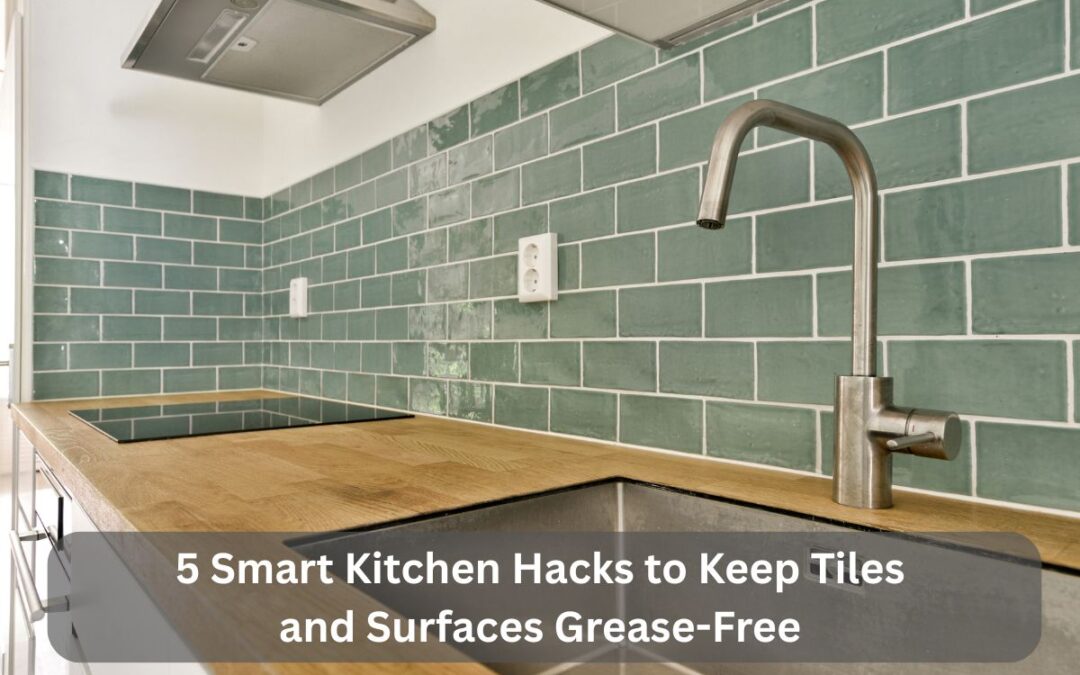Grease buildup in kitchens occurs when oil particles from cooking settle on tiles, countertops, and cabinets. Over time, these residues attract dirt, discolor surfaces, and create an unhygienic environment. Preventing grease requires both daily habits and strategic cleaning solutions.
Key Takeaways
- Kitchen grease forms when airborne oil droplets and food particles settle on tiles and surfaces.
- Regular maintenance reduces the need for harsh scrubbing or professional cleaning.
- Simple household ingredients like vinegar, baking soda, and lemon juice can act as natural degreasers.
- Protective measures, including splatter guards and tile sealants, minimize buildup.
- Consistency is key—combining small daily steps with deeper cleaning prevents long-term damage.
What Causes Grease Buildup in Kitchens?
Cooking oils and fats become airborne when heated. These particles mix with steam and smoke, settling onto nearby surfaces. Over time, they form sticky films that are difficult to remove. Common factors include:
- High-heat cooking: Frying, sautéing, and grilling release more oil vapors.
- Poor ventilation: Lack of exhaust fans or open windows traps grease in the air.
- Irregular cleaning: Allowing residues to sit leads to hardened layers.
- Tile porosity: Unsealed grout absorbs grease and stains more easily.
Fast Fact
According to a 2024 survey by the Home Hygiene Institute, 67% of homeowners identified greasy kitchen tiles as their toughest cleaning challenge.
Hack 1: Daily Wipe-Down with Natural Degreasers
The easiest way to keep tiles and surfaces grease-free is to prevent buildup in the first place. A quick daily wipe using natural cleaners helps break down oil residues before they harden.
Best Options
- White Vinegar Solution: Mix equal parts vinegar and warm water in a spray bottle. Spray onto tiles or countertops and wipe with a microfiber cloth. Vinegar dissolves grease effectively while disinfecting.
- Lemon Juice: The citric acid cuts through oils and leaves a fresh scent. Apply directly or mix with warm water for a light cleaning spray.
- Baking Soda Paste: For slightly sticky spots, apply a paste of baking soda and water, let it sit for a few minutes, then wipe clean.
Example
After frying food, spraying a vinegar solution on backsplash tiles and wiping immediately can prevent the thin film of grease from turning into a stubborn stain.
Hack 2: Use Protective Barriers During Cooking
Preventing grease from reaching tiles and surfaces is more efficient than cleaning it afterward. Protective barriers are inexpensive, reusable, and minimize mess.
Options for Protection
- Splatter Guards: Mesh or silicone covers for pans reduce oil spray while cooking.
- Aluminum Foil or Reusable Liners: Place behind stovetops or inside oven doors to catch splatters.
- Backsplash Panels: Install removable, washable panels that shield walls behind cooking zones.
Important
Never block ventilation while using barriers, as trapped heat or smoke can create other hazards.
Hack 3: Apply Sealants to Tiles and Grout
Grease often seeps into the porous grout between tiles, leading to permanent discoloration. Applying sealants creates a protective layer that repels oil and makes cleaning easier.
Types of Sealants
- Penetrating Sealers: Absorb into grout and tile pores, providing long-lasting protection.
- Topical Sealers: Form a surface coating, offering extra shine but may need reapplication more often.
Maintenance Tips
- Reapply sealant every 6 to 12 months depending on cooking frequency.
- Clean and dry tiles thoroughly before application for maximum effectiveness.
Fast Fact
Sealed grout resists up to 80% more stains than unsealed grout, according to a 2023 study by the Tile Council of North America.
Hack 4: Improve Ventilation and Air Circulation
Good airflow significantly reduces grease settling on surfaces. Kitchens without proper ventilation accumulate more sticky residues.
Practical Solutions
- Range Hoods: Use an exhaust hood whenever cooking, and clean the filters monthly.
- Open Windows: Create cross-ventilation to push greasy air outdoors.
- Ceiling or Portable Fans: Help circulate air and prevent vapors from clinging to surfaces.
- Dehumidifiers: Reduce moisture in kitchens, lowering the chances of oil sticking to damp tiles.
Example
A kitchen with a high-quality exhaust hood and regular filter cleaning will show less grease accumulation on cabinet tops compared to one without proper ventilation.
Hack 5: Schedule Deep Cleaning Sessions
Even with preventive measures, some grease will accumulate over time. Scheduling regular deep-clean sessions ensures long-term cleanliness and hygiene.
Effective Deep-Cleaning Methods
- Steam Cleaning: High-temperature steam loosens hardened grease on tiles and grout.
- Degreasing Sprays: Commercial degreasers can be used periodically, but always check labels for compatibility with tile surfaces.
- DIY Citrus Cleaner: Soak orange or lemon peels in vinegar for two weeks, strain, and use as a natural degreaser.
- Magic Erasers: Work well for tough stains on glossy tiles or laminate surfaces.
Frequency
- Weekly: Light scrubbing of stovetop and backsplash.
- Monthly: Wipe cabinet doors, handles, and countertops.
- Quarterly: Steam clean grout lines and reseal if necessary.
Important
Always test cleaning products on a small, hidden area first to avoid damaging finishes.
Example: Applying the 5 Hacks Together
Consider a household that regularly cooks fried food. By combining these hacks:
- They wipe tiles with vinegar spray daily.
- A splatter guard prevents heavy oil spray during frying.
- Tiles and grout are sealed every six months.
- The range hood is used consistently with filters cleaned monthly.
- A deep cleaning session is scheduled every quarter.
As a result, grease buildup is minimal, and the kitchen remains fresh and easy to maintain.
Preventive Maintenance Checklist
To make these hacks practical, homeowners can follow a simple checklist:
| Task | Frequency | Purpose |
|---|---|---|
| Daily wipe with vinegar | Daily | Prevents grease film from settling |
| Use splatter guards | When cooking | Reduces oil spray on tiles and surfaces |
| Clean range hood filter | Monthly | Improves ventilation and grease capture |
| Reseal grout and tiles | 6–12 months | Protects against permanent stains |
| Steam clean grout | Quarterly | Removes deep-seated grease and dirt |
FAQs
Why do kitchen tiles get greasy so quickly?
Tiles near cooking areas absorb airborne oil and steam particles, which settle and combine with dust to form sticky layers.
Can I use bleach to clean greasy tiles?
Bleach disinfects but is not an effective degreaser. Vinegar, baking soda, or commercial degreasers are more suitable.
What’s the safest natural degreaser?
White vinegar is the most effective natural solution for cutting through kitchen grease while being safe for most surfaces.
How often should I deep clean kitchen tiles?
A quarterly deep clean, combined with daily maintenance, keeps tiles grease-free and prevents buildup.
Are glossy tiles better than matte tiles for preventing grease?
Glossy tiles are easier to wipe clean, but grease can be more visible. Matte tiles hide stains better but may absorb oil faster if unsealed.
The Bottom Line
Keeping kitchen tiles and surfaces grease-free requires a mix of daily habits and strategic protection. Quick wipe-downs with natural degreasers, using barriers to prevent splatters, sealing grout, improving ventilation, and scheduling deep cleaning sessions together form a comprehensive approach.
By applying these five hacks consistently, homeowners can maintain hygienic, visually appealing kitchens with less effort, preventing long-term damage and ensuring a healthier cooking environment.

As the chief content writer, Hassan Al Sarker works as a professional kitchen-based content creator at Kitchen Liker.
In addition to reviewing the content published on Kitchen Liker, he ensures that it is accurate, relevant, and helpful. As a result, all the reviews and information published at Kitchen Liker are neutral and userfriendly.
Hassan Al Sarker has a bachelor’s degree in Hotel and Tourism Management From the Newyork University. Before joining Kitchen Liker, he was a contributor at Kitchen Club, United States.

